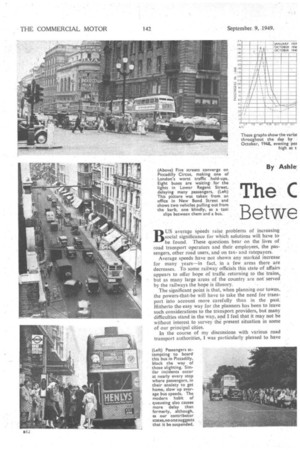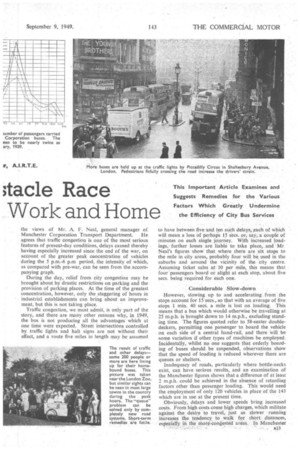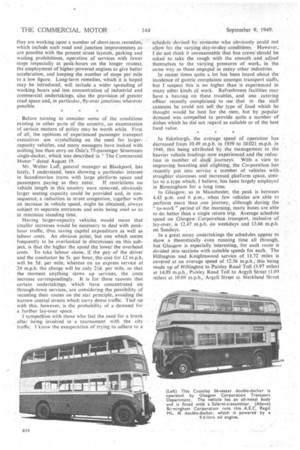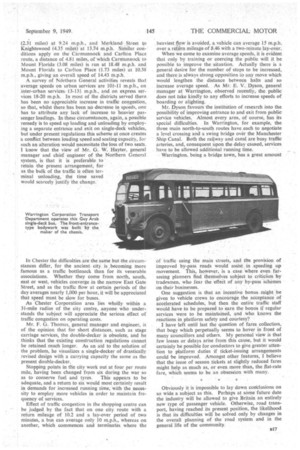The C Betwe ;thele Race Work and Home
Page 46

Page 47

Page 48

Page 51

If you've noticed an error in this article please click here to report it so we can fix it.
This Important Article Examines and Suggests Remedies for the Various Factors Which Greatly Undermine the Efficiency of City Bus Services
By Ashle r, A.I.R.T.E. BUS average speeds raise problems of increasing social significance for which solutions will have to be found. These questions bear on the lives of road transport operators and their employees, the passengers, other road users, and on taxand ratepayers.
Average speeds have not shown any marked increase for many years—in fact, in a few areas there are decreases. To some railway officials this state of affairs appears to offer hope of traffic returning to the trains, but as many large areas of the country are not served by the railways the hope is illusory.
The significant point is that, when planning our towns, the powers-that-be will have to take the need for transport into account more carefully than in the past. Hitherto the easy way for the planners has been to leave such considerations to the transport providers, but many difficulties stand in the way, and I feel that it may not be without interest to survey the present situation in some of our principal cities.
In the course of my discussions with various road transport authorities, I was particularly pleased to have
the views of Mr. A. F. Neal, general manager of Manchester Corporation Transport Department. He agrees that traffic congestion is one of the most serious features of present-day conditions, delays caused thereby having especially increased sincethe end of the war, on account of the greater peak ccmcentration of vehicles during the 5 p.m.-6 p.m period, the intensity of which, as compared with pre-war, can be seen from the accompanying graph.
During the day, relief from city congestion may be brought about by drastic restrictions on parking and the provision of parking places. At the time of the greatest concentration, however, only the ,staggering of hours in industrial establishments can bring about an improvement, but this is not taking place.
Traffic congestion, we must admit, is only part of the story, and there are many other reasons why, in 1949, the bus is not producing all the advantages which at one time were expected. Street intersections controlled by traffic lights and halt signs are not without their effect, and a route five miles in length may be assumed
to have between five and ten such delays, each of which will mean a loss of perhaps 15 secs. or, say, a couple of minutes on each single journey. With increased loadings, further losses are liable to take place, and Mr. Neal's figures show that where there are six stops to the mile in city areas, probably four will be used in the suburbs and around the vicinity of the city centre. Assuming ticket sales at 10 per mile, this means that four'passengers board or alight at each stop, about five secs. being required for each one.
Considerable Slow-down • However, slowing up to and accelerating. from the stops account for 15 sees., sotJiat with an average of five stops 1 min. 40 secs. a mile is lost on loading. This means that a bus which would otherwise be travelling at 25 m.p.h. is brought down to 14 m.p.h., excluding standing time. The figures quoted refer to 58-seater doubledeckers, permitting one passenger to board the vehicle on each side of a central hand-rail, and there Will be some variation if other types of machines be employed. Incidentally, whilst no one suggests that orderly, boarding of buses should be suspended, observations show that the speed of loading is reduced wherever there are queues or shelters.
Inadequacy of roads, particularly where bottle-necks exist, can have serious results, and an examination of the Manchester figures shows that a difference of at least 2 m.p.h. could be achieved in the absence of retarding factors other than passenger loading. This would need the employment of only 120 vehicles in place of the 143 which are in use at the present time.
Obviously, delays and lower speeds bring increased costs. From high costs come high charges, which militate against the deSire to travel, just as slower running increases the tendency to walk for short distances, especially in the more congested areas. In Manchester
they are working upon a number of short-term remedies, which include such road and junction improvements as are possible with the present street layouts, parking and waiting prohibitions, operation of services with fewer stops (especially at peak-hours on the longer routes), the employment of higher-powered engines to give better acceleration, and keeping the number of stops per mile to a low figure. Long-term remedies,-which it is hoped may be introduced, will include a wider spreading of working hours and less concentration of industrial and commercial -undertakings, also the provision of greater road space and, in particular, fly-over junctions wherever possible.
Before turning to consider some of the conditions existing in other parts of the country, an examination of certain matters of policy may be worth while. First of all, the opinions of experienced passenger transport executives are crystallizing on the need. for largercapacity vehicles, and many managers have looked with nothing less than envy on Oslo's 75-passenger Strommen single-decker, which was described in "The Commercial Motor" dated August 19.
Mr.; Walter Luff, general manager at Blackpool, has lately, I understand, been showing a particular interest in Scandinavian trams with large 'platform space and
passengers paying as they enter. If restrictions on vehicle length in this country were removed, obviously larger seating capacity could be provided and, in consequence, a reduction in street congestion, together with an increase in vehicle speed, might be obtained, always subject to separate entrances and exits being used so as to minimize standing time.
Having larger-capacity vehicles would mean that smaller increases Would be necessary to deal with peakhour traffic, thus saving capital expenditure as well as labour costs. An obvious point, but one which seems frequently to be overlooked in. discussionson this subject, is that the higher the speed.the lower' the Overhead costs. To take labour. alone, if.the pay of the driver and the conductor be 5s. per hour, the Cost for 12 m.p.h. will be 5d. per mile,' Whereas on an 'express service at 24 'm.p.h. the charge will be only 2W.. per mile, so that the moment anything slows up services, the costs increase correspondingly. .1t is for these reasons that certain • undertakings, which have concentrated on through-town services,' are considering the possibility of recasting their routes on the star principle, avoiding the narrow central streets .which carry dense traffic. Tied up with this, however, is the probability of a demand for
a further lay-over, space. • I sympathize with those who feel the need for a break after being involved in a tournament with the city traffic. I know the exasperation of trying to adhere to a schedule devised by soineone who obviously could not allow for the varying day-to-day conditions. However, I do not think it unreasonable that bus crews shouldbe asked' to take the rough with the smooth and adjust themselves to the• varying pressures -of work, in the same way as those engaged in mdny other industries
In recent times quite a lot has been heard about the incidence of gastric complaints amongst transport staffs, but I suspect this is no higher. 'than is experienced in many other kinds of work. Refreshment facilities may have a bearing onthese troubles, and one catering .officer recently complained to me that in the staff canteens he could not sell the .type of food which he thought would be best for the men, but by popular demand was. compelled to provide quite a number of dishes which he did not regard as suitable or of the best food value.
In Edinburgh, the average speed of operation has decreased from 10,49. m.p.h. in 1939 to 10.021 m.p.h. in 1948, this being attributed 'by. .the management to the heavier vehicle loadings now experienced and the reducticin in number • of •slack journeys. With a view to improving boarding and alighting, the Corporation has recently put into .service a number of vehicles with. straighter staircases and increased platform space, similar to a type which, I believe, has been largely employed in Birmingham for a long time. In Glasgow, as in Manchester, the peak is between 4.45 p.m. and 6 p.m., when few vehicles are able to perform more .than one journey, although during the " to-work " period of the Morning, many buses are able to do better than a single return trip. Average schedule speed on .afasgow. Corporation .transport, inclusive of lay-over, 12.47. m.p.h. On weekdays and 13.66 m.p.h. 011 Sundays. .. .
In a great many Undertakings the schedules appear to show a theoretically even running time all through, but Glasgow is especially interesting, for each route is divided into sections with suitable speeds for each. The Hillington and Knightswood service of 11.72 miles is covered at an average speed of 12.56 m.p.h.this being made up of Hillington to Paisley Road•Toil (3.97 miles) at 14.89 m.p.h., Paisley Road Toll to Argyll Street 11.09 miles) at 10.09 m.p.h., Argyll Street to Merkland Street (2.31 miles) at 9.24 m,p.h., and Merkland Street to Knightswood (4.35 miles) at 1334 m.p.h. Similar conditions apply on the Carmunnock and Carlton Place route, a distance of 4.81 miles, of -which Carrnunnock to Mount Florida. (3.08 miles) is run at 18.48 m.p.h. and Mount Florida to Carlton Place (1.73 miles) at 10.38 m.p.h., giving an overall speed of 14.43 m.p.h.
A survey of Ndrthern General activities reveals that average speeds on urban services are 10-11 m.p.h., on inter-urban services • 13-131 m.p.h., and on express services 18-20 m.p.h. In most of the districts served there has been no appreciable increase in traffic congestion, so that, whilst there has been no decrease in speeds, one has to attribute any lack of increase to heavier passenger loadings. In these circumstances, again, a possible remedy is to speed up loading and unloading by employing a separate entrance and exit on single-deck vehicles, but under present regulations this scheme at once creates a conflict between loading speed and seating capacity, for such an alteration would necessitate the loss of two seats. I know that the view of Mr. G.. W. Hayter, general manager and chief engineer of the Northern General system, is that it is preferable to
retain .the present arrangement, foras the bulk of the traffic is often terminal unloading, the time saved would scarcely 'justify the change.
In Chester the ditficulties,are the •sarrie but the.circumstances differ, for the ancient city. is .becoming. More famous as a traffic bottleneck than for its venerable associations. Whether they come from north, south, east or west, vehicles converge in the narrow East Gate Street, and as the traffic flow at certain periods of the day averages nearly 1,000 per hour, it will be appreciated that speed must be slow for buses.
As Chester Corporation area lies Wholly within a 3l-mile radius of the city centre, anyone who -understands the 'subject will appreciate the serious effect of traffic congestion on operating costs.
Mr. F. G. Thomas, general manager and engineer, is of the opinion that for short distances, such as stage carriage services, the double-decker is obsolete, and he thinks that the existing construction regulations cannot be retained much longer. As an aid to the solution of the problem, he visualizes a single-decker of drastically revised design with a carrying capacity the same as the present double-decker.
Stopping points in the city work out at four per route mile, having been changed from six during the war so
as to conserve fuel and tyres. This appears to be adequate, and a return to six would most certainly result in demands for increased running time, with the necessity to employ more vehicles in order to maintain frequency of services_
Effect of traffic congestion in the shopping centre can be judged by the fact that on one city route with a return mileage of 10.2 and a lay-over period of two minutes, a bus can average only 10 m.p.h., whereas on another, which commences and terminates where the
heaviest. flow is avoided, a. vehicle can average 15 m.p.h. over a ram mileage of 8.46 with a two-minute lay-over.
When we come to examine average speeds, it is evident that only by training or coercing the public will it be possible to improve the situation. Actually there is a general desire for the number of stops to be increased, and there is always strong opposition to arty move which would lengthen the distance between halts and so increase average speed. As Mr. E. V. Dyson, general manager at Warrington, observed recently, the. public does not take kindly to any efforts to increase speeds of boarding or alighting.
Mr. Dyson favours the institution of research into the possibility of improving entrance to and exit from public service vehicles. Almost every area, of course, has its special difficulties. In Warrington, for example, the three main north-to-south routes have each to negotiate a level crossing and a swing bridge over the Manchester Ship Canal. Both the railway and canal are busy traffic arteries, and, consequent upon the delay caused, services have to be allowed additional running time.
Warrington, being a bridge town, has a great amount
c..if traffic using the main streets, and the provision of improved by-pass roads would assist in speeding up movement. This, however, is a case where even farseeing planners find themselves subject to criticism by tradesmen, who fear the effect of any by-pass schemes on their businesses.
One suggestion is that an incentive bonusmight be given to vehicle crews to encourage the _acceptance of accelerated schedules, but then the entire traffic staff would have to be prepared to earn the bonus if regular services were to be maintained, and who knows the reactions in platform safety and courtesy?
I have left until last the question of fares collection, that bogy which perpetually seems to hover in front of many councillors and others. My personal view is that few losses or delays arise from this cause, but it would certainly be possible for conductors to give greater attention to platform duties if ticket-issuing arrangements could be improved. Amongst other features, I believe that the issue of season tickets at slightly reduced fares might help as much as, or even more than, the flat-rate fare, which seems to be an obsession with many.
Obviously it is impossible to lay down conclusions on so wide a subject as this. Perhaps at some future date the industry will be allowed to give Britain an entirely new type of passenger vehicle. Otherwise, road transport, having reached its present position, the likelihood is that its difficulties will be solved only by changes in the overall planning of the road system and in the general life of the community.




























































































